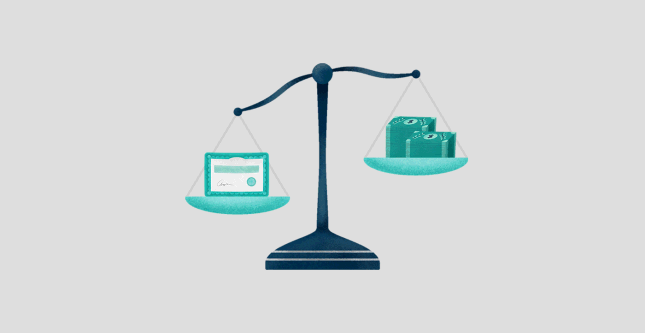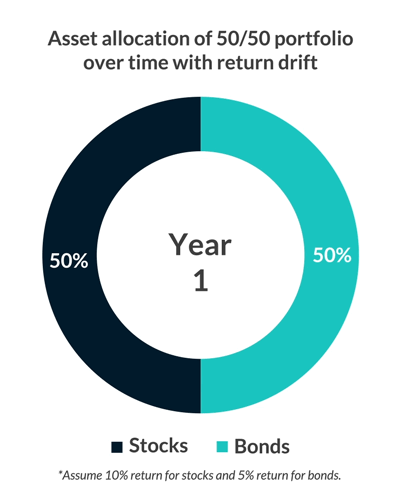Portfolio Investment: What You Need to Know
The importance of an expected return in a financial portfolio
A portfolio investment is an option that caters to those who prefer to choose from a range of different financial vehicles without the responsibility of actively participating in an underlying company or fund.
Leveraging portfolio investments is all about gauging expected returns, which are the profits or losses you reasonably expect your investment to generate based on known outcomes and risks. Understanding how to draw these conclusions can make it easier to pick assets to add to your financial portfolio.

Financial literacy is crucial to your investing strategies. Unfortunately, certain groups seem to be at a disadvantage when it comes to that knowledge. More specifically, populations like women, the economically underprivileged and the elderly tend to have less understanding of how investment and effective portfolio management work. Finding a tool that helps you understand passive investment basics is essential. There are many resources to choose from. Money and finance books, blogs and websites all have a great deal of information. Do your due diligence in verifying that the sources you choose are well-respected and reviewed.
For instance, imagine a particular stock as a portfolio investment. To assess the potential, you might start with historical data to see what that company achieved in the past.
Expected return calculations also shed light on your overall portfolio performance. If you invested $100,000 in a stock projected to return 10 percent during the next year and bought $200,000 of another anticipated to yield 20 percent over the same period, then your total expected return would be $50,000. This example made some that you would only earn the returns you anticipated if the stocks continued to perform well. Expected returns are hypothetical, so they should not be the only factors you consider when choosing investments.
Portfolio investment fundamentals
The way to make your passive income more lucrative is by getting acquainted with financial portfolio concepts as an excellent way to further your investment education.
Asset classes
Investment assets, like the securities and financial vehicles in your portfolio, can be broadly divided into equities and stocks, fixed income and bonds, cash equivalents and real estate.
These portfolio investments are derived through your ownership of a stake in a company. If you own equities or corporate stocks of a firm that does well, you might receive dividends corresponding to the profits left after the company’s creditors have been paid off. Stocks represent the divided ownership of a company, complete with certain voting rights.
Value investing is a common way to profit from stock investment by purchasing shares of undervalued companies. You can then hold the stock until the per-share price increases and sell it for more than what you originally paid. This growth of held value is known as capital appreciation.
Fixed-income investments are known for paying out as per predetermined investing schedules. As loans from investors to issuers, including corporations, governments or other entities, they repay principal with interest at rates that vary according to how creditworthy the issuers are. Some common forms of fixed-income investment include government bonds, corporate bonds, Treasury bills, and bond mutual funds.

Investors like cash equivalents because they offer enhanced liquidity. Although their returns are usually low, the fact that they have minimal risk makes them highly attractive. You might encounter cash equivalents in the form of Money Market Accounts (MMA), Certificates of Deposit (CD), and Treasury notes.
Investing in real estate property lets you choose a range of strategies for generating passive income. For example, some investors buy residential fixer-uppers and commercial properties to rent out or flip houses to sell in order to provide a secondary source of income.
Like other forms of passive investment, real estate lets you pick the degree of involvement you prefer. For instance, you can work with a Real Estate Investment Trust (REIT) to become a kind of virtual landlord while the trust oversees the property’s business aspects and material upkeep.
Risk tolerance
When constructing a financial portfolio, you need to choose a strategy that complements your immediate and long-term investment goals. Your risk tolerance directly impacts which investments are right for your portfolio investment.
Your risk tolerance represents the degree of investment return volatility that you are willing to accept. Since your returns will rarely materialize precisely as predicted, your investment strategy should be adaptable.
Investors with aggressive risk tolerances want the maximum possible returns and are willing to maximize their risk exposure to achieve them. These individuals commonly can put their money into portfolio investments like stocks, real estate, international securities and options.
Moderate risk tolerance investors take a more middle-of-the-road, balanced approach. They may not realize their portfolio income goals overnight, but it is due to their longer outlooks — typically about five to ten years.
Investors who have conservative risk tolerances tend to avoid financial portfolio volatility. Instead, they go for assets whose expected returns are almost guaranteed, and they commonly prefer the most liquid securities they can find, including bank CDs and MMAs. Many of these investors are approaching retirement age, so they want their incomes to grow consistently.
Investment horizon
Most portfolio investments usually are not fixed assets. You will need to sell or otherwise convert them to cash at some point. Your investment horizon defines the amount of time you plan on holding onto these assets and how it corresponds with your financial portfolio goals.

In addition to impacting your overall expected returns, your investment horizon should adapt as you age. For instance, you will probably lean toward more conservative, passive investments and remove the high-volatility assets from your portfolio as you gain experience and as you near retirement.
Funding your portfolio investment
One of the better things about constructing a mixed portfolio is that you get to decide how it grows your wealth. Instead of equally distributing a given sum, for instance, you can allocate specific amounts to different assets depending on your profit goals and risk tolerance.
Once you decide on the amount of money you are going to invest and to which opportunities, you need to set aside a certain amount, preferably every month, that will go towards your portfolio. Automatic deposits that are set up can transfer money to ensure that you are contributing to your financial portfolio. This requires planning on the front end but can pay off down the road.
Portfolio management tools
Building a portfolio is a lot easier when you have the right tools. Although the whole idea is to leverage passive investing techniques, investments are not going to be completely free of decisions. Good management tools help you accomplish tasks that build strong financial portfolios.
Online tools and apps can help in your financial planning and set a course for financial independence. Tools can be found for setting budgets and tracking everyday spending. Trying to reduce your debt in order to free up money for more investing? Apps and online tools can lay out a debt plan for your individual case. Finally, automating your bill payments and your investing deposits can also improve your financial health.
Understanding Modern Portfolio Theory
Harry M. Markowitz, a Chicago-born economics educator, developed a Nobel Prize-winning framework known as Modern Portfolio Theory (MPT). Also referred to as mean-variance analysis, MPT works to build financial portfolios that maximize yields.
The fundamental idea behind Modern Portfolio Theory is that rational investors will only assume more risk if they can realize higher returns. As a weighted sum, the model optimizes portfolios by quantifying asset-specific risks and volatility. The MPT techniques first espoused by Markowitz in the early 1950s have since become portfolio analysis standards among those who want to mix assets effectively without relying on impulses or vague opinions about diversification.
Portfolio types
You can apply the fundamentals of Modern Portfolio Theory to create a custom investment profile that serves various goals.
Aggressive portfolios contain stocks that make up for their high risks with potentially big rewards. These assets are characterized by high beta values, or sensitivities to external market conditions.

Defensive portfolios let conservative investors stabilize their holdings with stocks that deliver constant dividends. These assets tend to perform no matter whether the general market is on the upswing or experiencing a downturn.
Income portfolios, like those containing REITs, derive passive income from dividends and similar shareholder distributions to stakeholders.
Speculative portfolios include stocks that carry significant risks. For instance, you might put your money in penny stocks or invest in an emerging market sector in the hopes of unprecedented gains.
Hybrid portfolios are the catch-all option that includes everything else, including bonds, commodities and real estate.
Active vs. passive investors
In order to manage your portfolio investments effectively, you should begin by deciding whether you want to be an active or passive investor.
Active investors work to achieve short-term profits through continuous buying and selling. They constantly look for chances to generate portfolio income. By value investing and seizing on similar opportunities, they can benefit from short-term trades and manage risk proactively.
Passive investors, on the other hand, are typically more hands-off. They minimize their buying and selling to accumulate wealth gradually. Many succeed by buying investments and simply forgetting about them while they reap the potential rewards of capital appreciation. This approach may reduce the risk of investment mistakes which might result in losses.
Which option should you choose? Each has its pros and cons and there are multiple ways to structure your activities to control the cost of investing. For instance, active investors who pay per trade through traditional brokerages tend to incur higher fees than those who use modern, online platforms and pay lower fees. Similarly, semi-passive or passive investors who use traditional brokerages get struck with commissions and management fees while those who rely on independent or self-managed tools can enjoy low or no fees when investing online.
Investment tax implications
Fees are not the only things that take from your portfolio’s rate of return. Taxes are another big issue, and some low-fee brokerage options make it harder to avoid such hidden costs due to their overly simplistic approaches.
Working with online investing tools that give you complete control over your strategy may be the easiest way to stay ahead and maximize your compounding growth. Other tax-smart strategies include waiting to withdraw investment funds so that you can benefit from a more favorable tax bracket classification or avoid capital gains liabilities.
One popular option is known as Dollar Cost Averaging, or DCA. This technique involves buying into a given portfolio investment on a predetermined schedule. The dollar value of each purchase is the same, so the purchase volume can fluctuate based on the share price. Using dollar cost averaging may also help you weather market swings.
According to Modern Portfolio Theory, diversified portfolios should include a range of asset classes. This does not mean, however, that a portfolio is guaranteed to succeed just because it contains a distinctive combination of securities. Even if you are a passive investor, you will probably have to engage in asset allocation, or balancing your risks and rewards by adjusting your portfolio’s composition. For instance, you might divest yourself of equities that chronically underperform. Alternatively, you can stick to portfolio investment tools that automatically rebalance your holdings as needed.

Common Portfolio Investments
There are various options to gauge where you may find your individualized portfolio.
Retirement portfolios tend to focus on diversified, low-cost investments, including index funds, exchange-traded funds, IRAs, 401(k) accounts, private equity, real estate, individual stocks and bonds.
Equity portfolios commonly include mixed stock market investments that can help you tweak your rate of return. Most stocks include voting privileges. If you obtain a sufficient number of shares — more than 50 percent for a normal company or 66 percent for a Delaware firm — you essentially hold a direct investment because you have a deciding say in how the company operates.
Foreign portfolio investment, or FPI, involves purchasing financial assets tied to foreign enterprises. Some experts consider foreign portfolio investment less risky than foreign direct investment, or FDI, and it makes your money more liquid.
Enjoy hands-off portfolio investments with M1
Your investment strategy is only as effective as the platform behund it. M1 empowers you with the control capabilities to manage your money and build wealth the easy way. Due to its enhanced automation, you can leverage more than 80 model financial portfolios geared towards your preferred risk tolerance, time horizon and financial goals.
Why pay someone to build a portfolio you can build yourself with no fees or commissions. M1 lets you choose a strategy that increases your yields intuitively through automatic reinvestment and dynamic rebalancing. Want to feel more confident in your portfolio investment choices? Learn why most of our customers come from other brokers. All the benefits of a brokerage with none of the cost. Explore the benefits of M1 Finance by signing up for a free account today.